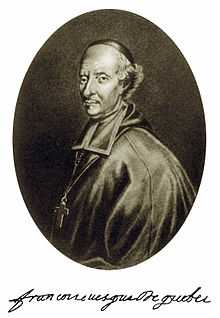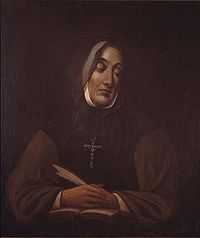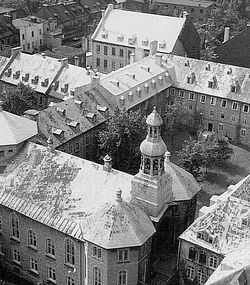Ursulines of Quebec
| Museum of the Ursuline Convent in Quebec City Musée des Ursulines de Québec | |
|---|---|
|
Ursuline Monastery of Quebec | |
| Established | 1639 |
| Location | Quebec City, Quebec, Canada |
| Type | religious museum and teaching centre |
| Website | |
| Official name | Ursuline Monastery National Historic Site of Canada |
| Designated | 1972 |
The Ursuline Convent of Quebec City, (French: Couvent Ursulines de Québec), founded in 1639, is the oldest institution of learning for women in North America. Today, the convent operates an historical museum[1] and teaching centre.[2]
The complex was designated a National Historic Site of Canada in 1972.[3]
Background
The Ursulines are a Roman Catholic (Christian) religious order founded at Brescia, Italy by Saint Angela de Merici in 1535, primarily for the education of girls and the care of the sick and needy. Their patron saint is Saint Ursula.
The Viceroyalty of New France was the area colonized by France in North America starting with the exploration of the Saint Lawrence River by Jacques Cartier in 1534. The French explorer Samuel de Champlain founded the city of Québec in 1608 among the Algonquin people as the administrative seat for New France. Colonization was slow and difficult. Many settlers died early, because of harsh weather and diseases. In 1630, there were only 103 colonists living in the settlement, but, by 1640, there were 355.
History

The history of the Ursulines in Quebec begins on 1 August 1639, when its first members landed in Canada. The convent was established under the leadership of Mother (now Blessed) Marie of the Incarnation (1599–1672), an Ursuline nun, and Madame Marie-Madeline de Chauvigny de la Peltrie (1603–1671), a rich widow from Alençon in Normandy. The letters royal sanctioning the foundation are dated 1639.
After three years spent in the Lower Town of Quebec City, the nuns moved to the convent built on the ground they still occupy, ceded to them by the Company of New France. Their first pupils were Indian girls, with whom they succeeded better than the Jesuits with their native boys. The first convent was burned in 1650, but was soon rebuilt.
The Constitutions, written by Father Jérôme Lalemant (1593–1673), uncle of the Jesuit martyr Gabriel Lalemant, combined the rules of the two Congregations of Paris and Bordeaux, and were observed until Bishop François de Laval decided in 1681 in favor of the former, which binds its members by a fourth vow to teach girls.
Marie de l'Incarnation, the foundress, practiced devotion to the Sacred Heart of Jesus, and had established it in the cloister years before the revelation to the blessed Margaret Mary (1647–1690). The first celebration of the feast in the New World took place in the monastery 18 June 1700. The register of the Confraternity of the Sacred Heart begins in 1716. Pope Clement XI (1718) enriched it with indulgences.
The convent was threatened by the Iroquois in 1661-2, when one of its chaplains, the Sulpician Vignal, was slain and devoured[4] near Montreal.

The convent underwent the siege and bombardment of Quebec by Phips in 1690, and a second siege by Wolfe in 1759. After the battle of 13 September 1759, where the garrison of Quebec was defeated by Wolfe's army, the French governor, Montcalm, was buried by night in the convent chapel. The first English governor, Murray, used part of the monastery as his headquarters. On that occasion the rations served to the nuns for nursing the wounded and sick saved them from perishing of starvation. The governors and viceroys, both English and French, were always friendly to the institution.
The Quebec convent founded convents at Three Rivers in 1697, Roberval in 1882, Stanstead in 1884, and Rimouski, with a normal school, in 1906, besides sending missionaries to New Orleans in 1822, Charlestown (Boston) in 1824, Galveston in 1849 and Montana in 1893.
Notable people

The foundress, the Blessed Marie of the Incarnation, mastered the local languages and composed dictionaries in Algonquin and Iroquois, a sacred history in Algonquin, and a catechism in Iroquois.
The first superior elected (1760) after the conquest was Esther Wheelwright, a New England captive,[5] rescued from the Abenakis by the Jesuit Bigot, and a protégée of the first governor, Vaudreuil. The Irish, Scottish and American elements in Canada have given distinguished subjects to this cloister, prominent among whom was mother Cecilia O'Conway of the Incarnation, the first Philadelphia nun, one of Mother Seton's earliest associates. The list of alumnae includes Jeanne Le Ber (1662–1714)), the saintly "recluse of Montreal", and Saint Mother D'Youville(1701–1771), foundress of the Grey Sisters at Montreal.
During the French Revolution (1789–1799) several French refugees were chaplains to the monastery, the most notable being Abbé L.P. Desjardins, who died in France, Vicar-General of Paris. Through him were procured the valuable paintings by Philippe de Champaigne, Charles Le Brun, Hyacinthe Collin de Vermont, Pietro da Cortona and others, that adorn the chapel.
Today

The convent has many of its original walls intact and houses a little chapel and a museum. It is located at 12 Rue Donnacona in the middle of the historical district of Quebec City, which is recognized by UNESCO as a World Heritage District. The associated school has two campuses. In the Quebec City campus, there are more than four hundred girls enrolled from pre-school through primary school (5 to 12 years). There is also a coeducational campus in Loretteville.
Affiliations
The Museum is affiliated with: CMA, CHIN and Virtual Museum of Canada.
See also
- Ecole des Ursulines, Quebec
- Ursulines
References
- ↑ Ursuline Museum website
- ↑ Ecole des Ursulines official website
- ↑ Ursuline Monastery. Canadian Register of Historic Places. Retrieved 2011-09-17.
- ↑ 1907 report by the Bureau of American Ethnology on cannibalization in North America
- ↑ Puritan child, native daughter, mother superior Globe and Mail book review, 2011 April 22
| Wikimedia Commons has media related to Ursulines of Quebec. |
External links
- New Advent Catholic Encyclopedia
- Article by Sister Mary of Jesus in 1948
- The Ursuline entry in The Catholic Encyclopedia
![]() This article incorporates text from a publication now in the public domain: Herbermann, Charles, ed. (1913). Catholic Encyclopedia. Robert Appleton Company.
This article incorporates text from a publication now in the public domain: Herbermann, Charles, ed. (1913). Catholic Encyclopedia. Robert Appleton Company.
| ||||||||||||||||||||||||||||||||||||||||||
| ||||||||||||||||||||||||||||||||||||||||||||||||
| ||||||||||||||||||
Coordinates: 46°48′44″N 71°12′29″W / 46.812094°N 71.208127°W
